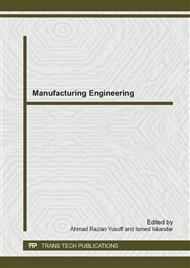p.175
p.181
p.187
p.194
p.200
p.209
p.215
p.221
p.227
Heat Generation Performance of a Homemade Friction Stir Welding Tool
Abstract:
Friction Stir Welding (FSW) is getting its popularity because it is considered as an environmentally friendly manufacturing. Homemade FSW tool to be attached to a conventional milling machine was designed and fabricated. Experimental investigation of FSW process of the Aluminum alloy work piece to observe its heat generation was performed. Since heat generation is the main objective in a FSW process, the importance of identification of heat generation performance in a welded specimen is paramount. Heat generation of a welded specimen during FSW was measured using infra red thermal camera. The limitation of the measurement is it only captured the heat generation at surrounding area and surface of the welded specimen. Therefore, the heat generation inside contact area could not be identified. To overcome this problem, a finite-element model of the FSW process was developed. A model consists of a solid model of half the welded specimen since the symmetrical behavior of the geometry and boundary condition was assumed. Heat transfer analysis of a solid body model of a work piece was computed. It was observed that FSW parameters which involved dominantly in the heat generation were spindle speed, feeding rate and normal force. The heat generation model of FSW process was validated with the one from the experimental investigation. Good agreement between the numerical and the experimental investigation result has been made.
Info:
Periodical:
Pages:
200-205
Citation:
Online since:
February 2014
Authors:
Price:
Сopyright:
© 2014 Trans Tech Publications Ltd. All Rights Reserved
Share:
Citation:


